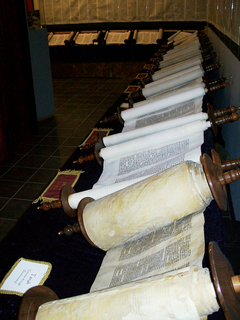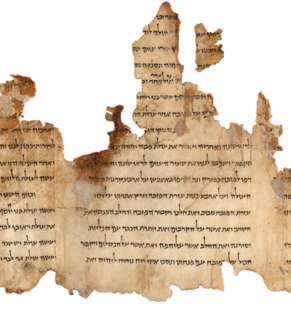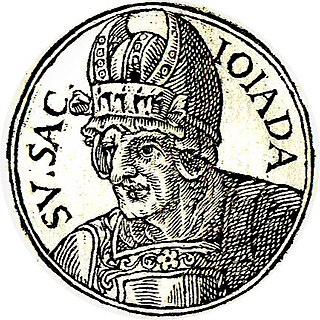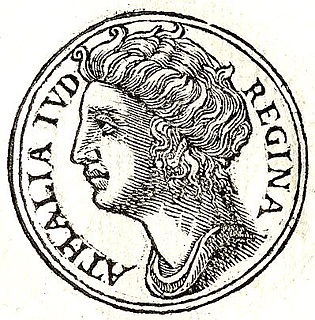
The Book of Zechariah, attributed to the Hebrew prophet Zechariah, is included in the Twelve Minor Prophets in the Hebrew Bible.
The name Abda means servant, or perhaps is an abbreviated form of servant of YHWH. There are two people by this name in the Hebrew Bible.
Achbor is a name that means "gnawing" and is, by extension, used as the word for "mouse". There are at least two persons by this name in the Hebrew Bible.
Achish (אָכִישׁ) is a name used in the Hebrew Bible for two Philistine rulers of Gath. It is perhaps only a general title of royalty, applicable to the Philistine kings. The two kings of Gath, which is identified by most scholars as Tell es-Safi, are:
This article incorporates text from a publication now in the public domain: Easton, Matthew George (1897). "Ahijah" . Easton's Bible Dictionary. T. Nelson and Sons.
Shebna was "treasurer over the house" in the reign of king Hezekiah of Judah, according to the Hebrew Bible.
Ophrah, is a name in the Hebrew Bible meaning "a fawn" given to:

Joab the son of Zeruiah, was the nephew of King David and the commander of his army, according to the Hebrew Bible.

Uzziah, also known as Azariah, was a king of the ancient Kingdom of Judah, and one of Amaziah's sons. Uzziah was 16 when he became king of Judah and reigned for 52 years. The first 24 years of his reign were as co-regent with his father, Amaziah.

Amaziah of Judah, (pronounced, Hebrew: אֲמַצְיָהוּ, ʼĂmaṣyāhû, meaning "the strength of the Lord," "strengthened by Yahweh," or "Yahweh is mighty"; was a king of Judah, the son and successor of Joash. His mother was Jehoaddan and his son was Uzziah. He took the throne at the age of 25, after the assassination of his father, and reigned for 29 years, 24 years of which were with the co-regency of his son. The second Book of Kings and the second Book of Chronicles in the Hebrew Bible consider him a righteous king, but with some hesitation. He is praised for killing the assassins of his father only and sparing their children, as dictated by the law of Moses.
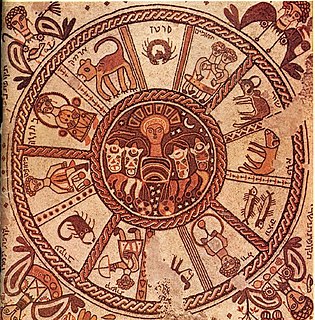
Mazzaroth is a Biblical Hebrew word found in the Book of Job and literally meaning 'a garland of crowns'. but its context is that of astronomical constellations, and it is often interpreted as a term for the zodiac or the constellations thereof. . The similar word mazalot (מַּזָּלוֹת) in 2 Kings 23:3-5 may be related.
Abomination is an English term used to translate the Biblical Hebrew terms shiqquts שיקוץ and sheqets שקץ, which are derived from shâqats, or the terms תֹּועֵבָה, tōʻēḇā or to'e'va (noun) or ta'ev (verb). An abomination in English is that which is exceptionally loathsome, hateful, sinful, wicked, or vile.
Abila – also biblical: Abel-Shittim or Ha-Shittim – was an ancient city east of the Jordan River in Moab, later Peraea, near Livias, about twelve km. northeast of the north shore of the Dead Sea; the site is now that of Abil-ez-Zeit, Jordan.
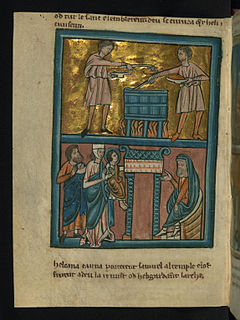
Hophni and Phinehas or Phineas were the two sons of Eli. The first book of Samuel describes them as the officiating priests at the sanctuary of Shiloh at the time of Hannah. According to Josephus, Phinehas officiated as high priest because Eli had resigned as high priest at Shiloh because of his advanced age.
Kir of Moab is mentioned in the Hebrew Bible as one of the two main strongholds of Moab, the other being Ar. It is probably the same as the city called Kir-haresh, Kir-hareseth, and Kir-heres. The word Kir alludes to a wall or fortress. It is identified with the later city Al Karak.

Alcoholic beverages appear in the Hebrew Bible, after Noah planted a vineyard and became inebriated. In the New Testament, Jesus miraculously made copious amounts of wine at the marriage at Cana. Wine is the most common alcoholic beverage mentioned in biblical literature, where it is a source of symbolism, and was an important part of daily life in biblical times. Additionally, the inhabitants of ancient Israel drank beer, and wines made from fruits other than grapes, and references to these appear in scripture.
The Ophel, also Graecised to Ophlas, is the biblical name apparently given to a certain part of a settlement or city that is elevated from its surroundings, and probably means fortified hill or risen area. In the Hebrew Bible the Ophel refers to a specific part in two cities: the extended City of David, as in the Book of Chronicles and the Book of Nehemiah, and at Samaria, the ancient capital of the Kingdom of Israel, mentioned in the Second Book of Kings. The Mesha Stele is the only extra-biblical source using the word, also in connection to a fortified area.

According to the Hebrew Bible, Solomon's Temple, also known as the First Temple, was the Holy Temple in ancient Jerusalem before its destruction by Nebuchadnezzar II after the Siege of Jerusalem of 587 BCE and its subsequent replacement with the Second Temple in the 6th century BCE. The period in which the First Temple presumably, or actually, stood in Jerusalem, is known in academic literature as the First Temple period.
The public domain consists of all the creative works to which no exclusive intellectual property rights apply. Those rights may have expired, been forfeited, expressly waived, or may be inapplicable.
Matthew George Easton was a Scottish minister and writer. His most known work is the Easton's Bible Dictionary, published three years after his death.

The Illustrated Bible Dictionary, better known as Easton's Bible Dictionary, is a reference work on topics related to the Christian Bible compiled by Matthew George Easton. The first edition was published in 1893, and a revised edition was published the following year. The most popular edition, however, was the third, published by Thomas Nelson in 1897, three years after Easton's death. The last contains nearly 4,000 entries relating to the Bible. Many of the entries in Easton's are encyclopedic in nature, although there are also short dictionary-type entries.
